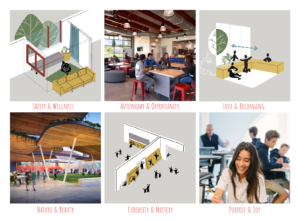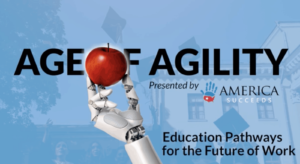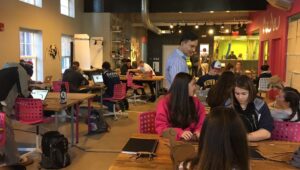Education in the Age of Agility

Since its inception, the American public education system has always held ties to the economy and been driven by advances in technology. Martin Trow, a professor at UC Berkeley, argued in 1961 that much of the establishment of public education can be attributed to the shift from an agricultural to an industrial economy resulting in increased reliance on paper. Because businesses required paper to efficiently communicate instructions and messages to their workforce, the economy needed a more literate population—hence, school.
With the publication of A Nation at Risk in 1983, the business community has driven policy makers to envision an education system that prepares students for an Information Era. The idea that students require more modern skills further exploded at the turn of the century. From the Partnership for 21st Century Learning to the World Economic Forum, business organizations and coalitions have advocated for widespread innovation in education to prepare students for ubiquitous technology, exponential rates of change, and expanding globalization. Just this past week, the Age of Agility Alliance went public to “ensure all learners are prepared to succeed in a competitive global economy and contribute to their local community.”
A New Form of Alliance
Members of the Age of Agility Alliance advocate that today’s students, teachers, and school systems require the capacity to adapt to an ever-changing world. An initiative of America Succeeds—a national network of nonprofit, non-partisan, policy and advocacy organizations dedicated to bringing the business and education sectors together—the Agility Alliance endeavors to improve the education-to-employment pipeline as a means to ensure that the United States does not fall behind countries with more nimble education systems. As such, the Alliance intends to provide companies, policymakers, and education organizations with a call-to-action to prepare students for this Age of Agility while simultaneously providing support to modernize public education and build new workforce training.
Driven by the idea that the rise of Artificial Intelligence, automation, and big data will dramatically change the skills required by workers, the Alliance wants education to ensure that students graduate with the flexibility, lifelong learning, critical thinking, and creative problem solving (aka “agility”) skills to be successful in the economy and society. To do this, they envision “an agile system that is nimble and responsive to the needs of learners, incenting the development of a diverse array of opportunity pathways with permeability between school and work.” Organizations who have joined the Alliance have then agreed to a shared mission:
- Embed agility as a core tenant of education systems in every state, as demonstrated by the adoption of state-level policy and strategies to create more agile learners, educators and systems.
- Expand pathways and increase access from K-12 to high-quality post-secondary programs and industry credentials to promote the seamless progression from education to career.
Representing multiple sectors, business affiliations, and stakeholder groups, the inaugural cohort of the Alliance includes over 30 partners. From the corporate sector, Walmart and Tyson have pledged support, as have the job market analytics company Burning Glass Technologies, the for-profit Universal Technical Institute, and Crown Equipment Corporation (a forklift and materials company). Nonprofit organizations and associations span equally diverse groups to include education-based nonprofits like Digital Promise, Mastery Transcript Consortium, and Project Lead the Way, as well as Associated Builders and Contractors—a national trade association that supports construction—and The Manufacturing Institute, a social impact organization with a mission to increase education about manufacturing. Beyond traditional education-oriented foundations, others such as the American Hotel and Lodging Foundation, National Retail Foundation, and U.S. Chamber of Commerce Foundation have pledged support. Finally, the desire to change education as a means to improve the workforce exists as a shared tenet with each of the state-based organizations. For example, whereas Arkansas Learns and Idaho Business for Education focuses on talent development as a means to improve economic development, Colorado Succeeds and Best NC endeavor to improve education through policy advocacy and philanthropy.
From Talk to Action
In 2017, America Succeeds released their first report, The Age of Agility: Education Pathways for the Future of Work, which called for today’s high school and college graduates to be prepared for an uncertain era of rapid change. Using the report as a call-to-action, America Succeeds and the U.S. Chamber of Commerce Foundation collaboratively launched a National Tour over the past year to engage in conversations about education and inspire a movement.
To share their learning from this Tour, the Alliance has now released a new report to describe three emergent ideas. First, students need to become lifelong learners who possess both academic and workforce skills, the capacity to continuously improve, and the ability to create their own pathways as jobs evolve or disappear. Next, education systems must emphasize lifelong learning, have policies that advocate for multiple pathways, and include accountability systems that respond to the needs of learners and the workforce. Finally, the Alliance espouses that educators should be valued and prepared to also be lifelong learners who can adapt to changing conditions and apply their skills across the workforce. With these three ideas, the Alliance ultimately hopes that states will embrace this idea of agility and embed it into their policies.
From Economics to History
In their 1995 book, Tinkering Toward Utopia, David Tyack and Larry Cuban wrote that policy reforms are both incremental and cyclical. However, as old ideas cycle back around, incremental changes over time make them appear new or different. The business community has always advocated that education should prepare students for work, and calls for 21st century or agility skills have been in existence for decades. However, it is important to remember that the history of American education transcends the economy.
In the 19th century, the public education system emerged not only as a means to improve the efficiency of the labor market but also to transcend family, religion, and individual farms such that it could assimilate immigrants, address urbanization, and purportedly prepare citizens for participation in a democracy. And yet, as Tyack and Cuban explained, it was an unequal system of gross inequity. Though established as a public good, the American education system has never equitably benefited the entire public.
The Agility Alliance is the latest group to bring attention to education from the business community. Their call-to-action mirrors that of many organizations who have come before them. The promise now lies in their focus on encouraging lifelong learning, empowering educators, and advocating for policy that values change.
For more, see:
- Let’s Make Sure America Succeeds in the Age of Agility
- Cross-Sector Collaboration for the Age of Agility
- Commentary: In Our Changing Economy, We Need New Flexible Education Systems to Usher in an Age of Agility for Tomorrow’s Workforce
Stay in-the-know with innovations in learning by signing up for the weekly Smart Update. This post includes mentions of a Getting Smart partner. For a full list of partners, affiliate organizations and all other disclosures, please see our Partner page.







Eklavya Education
I used to read your blog and found them very interesting, keep posting like this many more. Find CBSE for Class 9th study material on the best learning site for students, that is, Eklavya Education.
Chakri
HOST eLearning platform.